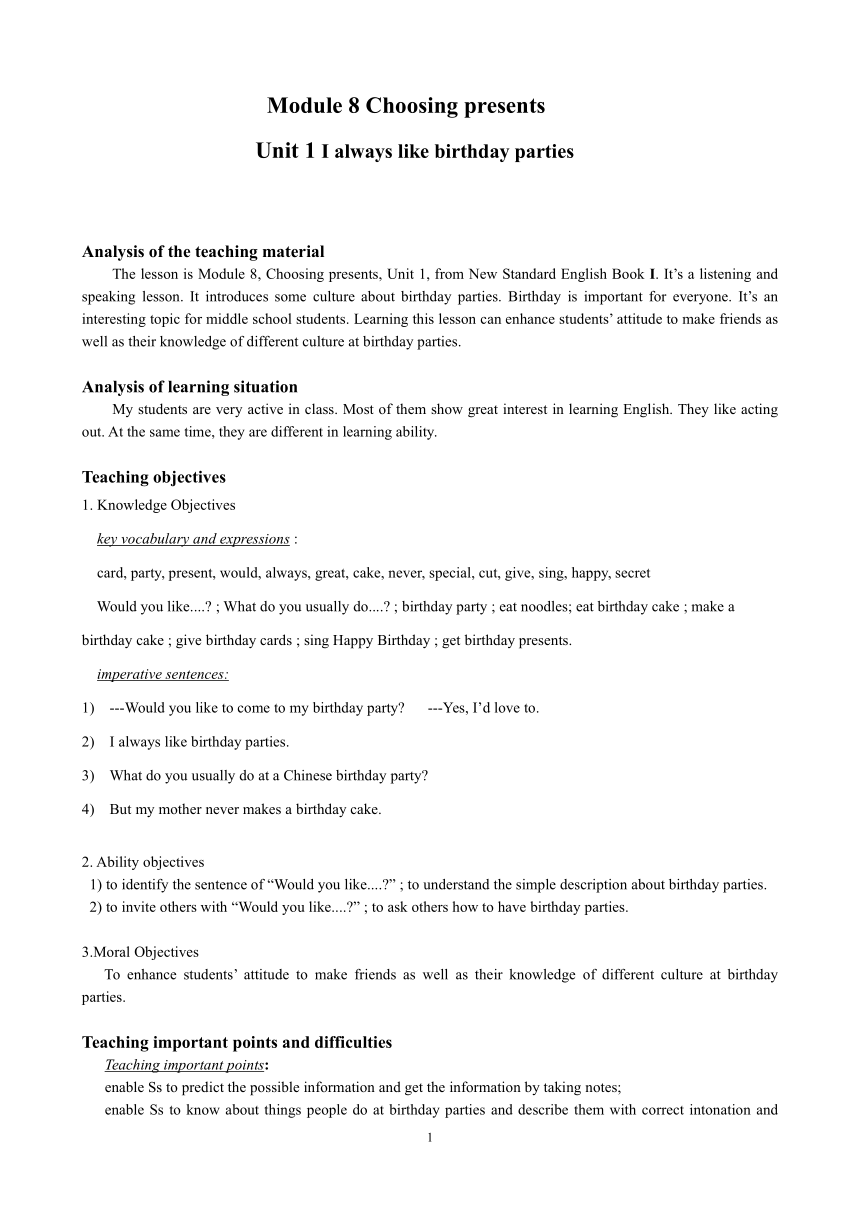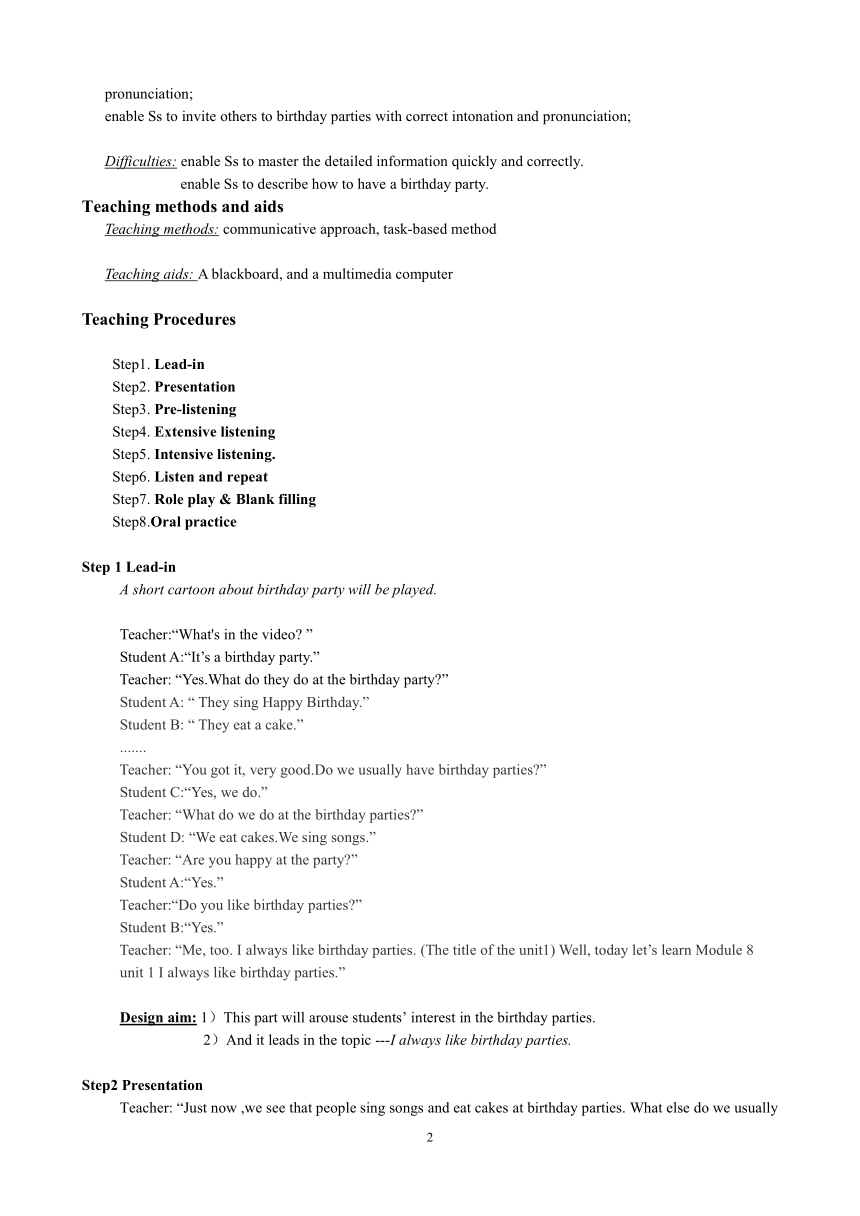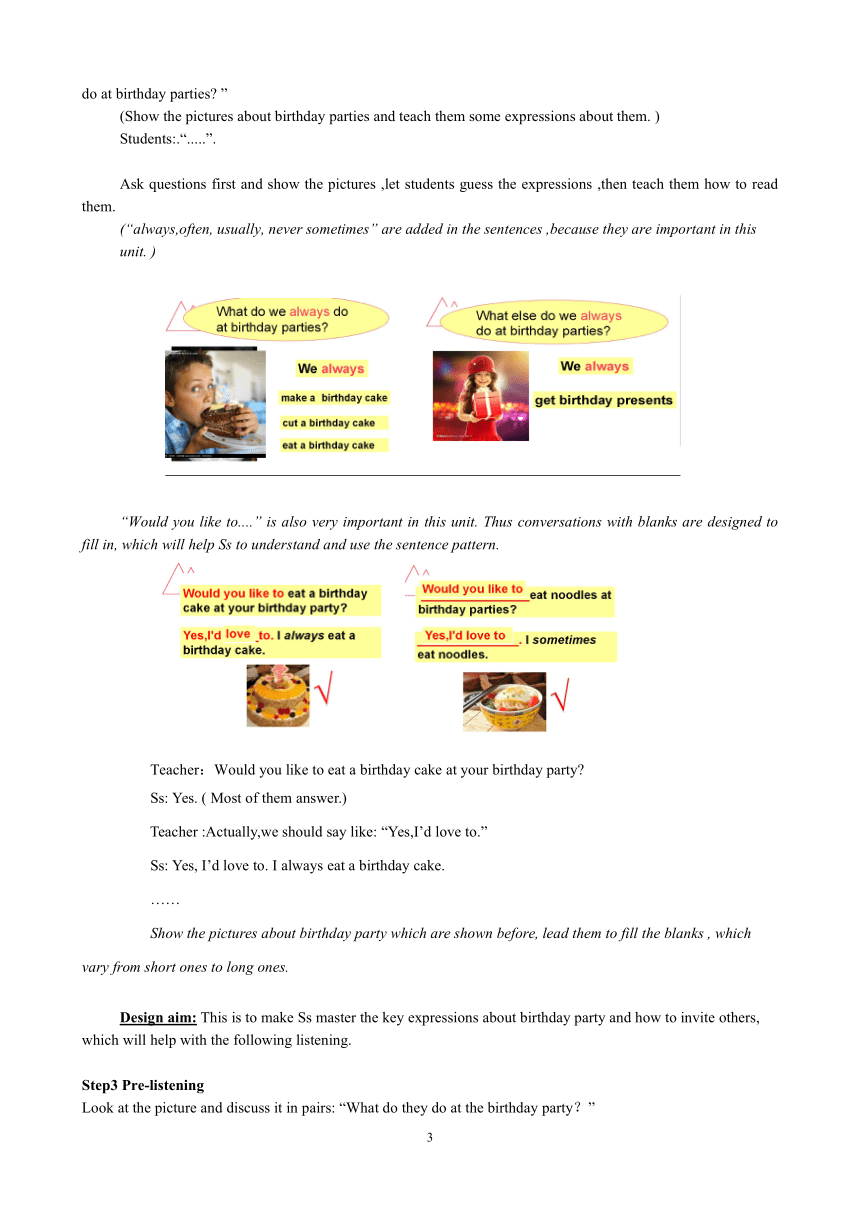Module 8 Choosing presents Unit 1I always like birthday parties.教案
文档属性
| 名称 | Module 8 Choosing presents Unit 1I always like birthday parties.教案 |  | |
| 格式 | doc | ||
| 文件大小 | 1.7MB | ||
| 资源类型 | 教案 | ||
| 版本资源 | 外研版 | ||
| 科目 | 英语 | ||
| 更新时间 | 2020-09-26 13:20:55 | ||
图片预览



文档简介
Module 8 Choosing presents
Unit 1 I always like birthday parties
Analysis of the teaching material
The lesson is Module 8, Choosing presents, Unit 1, from New Standard English Book I. It抯 a listening and speaking lesson. It introduces some culture about birthday parties. Birthday is important for everyone. It抯 an interesting topic for middle school students. Learning this lesson can enhance students attitude to make friends as well as their knowledge of different culture at birthday parties.
Analysis of learning situation
My students are very active in class. Most of them show great interest in learning English. They like acting out. At the same time, they are different in learning ability.
Teaching objectives
1. Knowledge Objectives
key vocabulary and expressions :
card, party, present, would, always, great, cake, never, special, cut, give, sing, happy, secret
Would you like....? ; What do you usually do....? ; birthday party ; eat noodles; eat birthday cake ; make a birthday cake ; give birthday cards ; sing Happy Birthday ; get birthday presents.
imperative sentences:
---Would you like to come to my birthday party? ---Yes, I抎 love to.
2) I always like birthday parties.
3) What do you usually do at a Chinese birthday party?
4) But my mother never makes a birthday cake.
2. Ability objectives
1) to identify the sentence of 揥ould you like....? ; to understand the simple description about birthday parties.
2) to invite others with 揥ould you like....? ; to ask others how to have birthday parties.
3.Moral Objectives
To enhance students attitude to make friends as well as their knowledge of different culture at birthday parties.
Teaching important points and difficulties
Teaching important points:
enable Ss to predict the possible information and get the information by taking notes;
enable Ss to know about things people do at birthday parties and describe them with correct intonation and pronunciation;
enable Ss to invite others to birthday parties with correct intonation and pronunciation;
Difficulties: enable Ss to master the detailed information quickly and correctly.
enable Ss to describe how to have a birthday party.
Teaching methods and aids
Teaching methods: communicative approach, task-based method
Teaching aids: A blackboard, and a multimedia computer
Teaching Procedures
Step1. Lead-in
Step2. Presentation
Step3. Pre-listening
Step4. Extensive listening
Step5. Intensive listening.
Step6. Listen and repeat
Step7. Role play & Blank filling
Step8.Oral practice
Step 1 Lead-in
A short cartoon about birthday party will be played.
Teacher:揥hat's in the video?
Student A:Its a birthday party.
Teacher: 揧es.What do they do at the birthday party?
Student A: They sing Happy Birthday.
Student B: They eat a cake.
.......
Teacher: 揧ou got it, very good.Do we usually have birthday parties?
Student C:揧es, we do.
Teacher: 揥hat do we do at the birthday parties?
Student D: 揥e eat cakes.We sing songs.
Teacher: 揂re you happy at the party?
Student A:Yes.
Teacher:揇o you like birthday parties?
Student B:Yes.
Teacher: 揗e, too. I always like birthday parties. (The title of the unit1) Well, today let抯 learn Module 8
unit 1 I always like birthday parties.
Design aim: 1)This part will arouse students’ interest in the birthday parties.
2)And it leads in the topic ---I always like birthday parties.
Step2 Presentation
Teacher: “Just now ,we see that people sing songs and eat cakes at birthday parties. What else do we usually do at birthday parties?
(Show the pictures about birthday parties and teach them some expressions about them. )
Students:.......
Ask questions first and show the pictures ,let students guess the expressions ,then teach them how to read them.
(揳lways,often, usually, never sometimes are added in the sentences ,because they are important in this
unit. )
揥ould you like to.... is also very important in this unit. Thus conversations with blanks are designed to fill in, which will help Ss to understand and use the sentence pattern.
Teacher:Would you like to eat a birthday cake at your birthday party?
Ss: Yes. ( Most of them answer.)
Teacher :Actually,we should say like: 揧es,Id love to.
Ss: Yes, I抎 love to. I always eat a birthday cake.
厖
Show the pictures about birthday party which are shown before, lead them to fill the blanks , which vary from short ones to long ones.
Design aim: This is to make Ss master the key expressions about birthday party and how to invite others,
which will help with the following listening.
Step3 Pre-listening
Look at the picture and discuss it in pairs: “What do they do at the birthday party?”
Ss:What do they do at the birthday party?
Ss: They eat birthday cakes.
Ss: They sing Happy Birthday.
…..
Teacher: Good. The party seem pretty interesting. Would you like to come to the party?
Ss: Yes,I抎 love to.
Teacher: Let抯 go and listen.
Design aim: In this way, the students can master the key expressions about birthday party, which makes the listening easier for them to understand.
Step 4: Extensive listening .
(activity 2)
In this part, encourage Ss to imagine what happen in the conversation and guess the order of the words.
activity 3
In this part, the questions are easy and basic for Ss to answer ,which helps Ss to understand the main idea.
Before listening, Ss are asked to mark the key part of the question ,such as,揥ould you like.敁Where
,which can help Ss to predict and get the information quickly.
Design aim: This is to help students to predict and get the information and get the main idea of the conversation .
Step5 Intensive listening
In this part, questions are more detailed. Ss are asked to read the given sentences before listening, paying attention to the key words(with blue underlines) and predict the possible mistakes.
Ss are asked to take notes when necessary.
And then check the true sentences and find out the mistakes .
Design aim: Cultivate stundets ability of getting the detailed information from the listening ,especially by prediction and note- taking.
Step6 Listen and repeat
In this step, students are supposed to read after the tape , paying much attention to the intonation and pronunciation.
Design aim: Cultivate students correct intonation and pronunciation.
Step7 Role play & Blank filling
Ss are supposed to work in a group of 4, and act out the conversation .
Ss are supposed to fill the blanks ,closing books. (To make the blanks easy, there are related pictures beside the blanks.)
Design aim: Cultivate students correct intonation and pronunciation. And help them understand the passage more and recite the key expressions about birthday party, which will help with the following oral practice.
Step 8 Oral practice.
Teachers introduce the culture about Christmas and its party.
Ss are supposed to talk about the Christmas parties, according to the given pictures. Ss are supposed to use 揥ould you like? 搒ometimes, usually厰 and some expressions about party.
Design aim: Enable Ss to invite others to a Christmas party and use the key expressions about party.
Arouse students interest on Christmas and western culture.
Teaching evaluation
Advantages: good pronunciation, natural transition, logical organization
Disadvantages: teaching contents look not so rich and interesting
6
Unit 1 I always like birthday parties
Analysis of the teaching material
The lesson is Module 8, Choosing presents, Unit 1, from New Standard English Book I. It抯 a listening and speaking lesson. It introduces some culture about birthday parties. Birthday is important for everyone. It抯 an interesting topic for middle school students. Learning this lesson can enhance students attitude to make friends as well as their knowledge of different culture at birthday parties.
Analysis of learning situation
My students are very active in class. Most of them show great interest in learning English. They like acting out. At the same time, they are different in learning ability.
Teaching objectives
1. Knowledge Objectives
key vocabulary and expressions :
card, party, present, would, always, great, cake, never, special, cut, give, sing, happy, secret
Would you like....? ; What do you usually do....? ; birthday party ; eat noodles; eat birthday cake ; make a birthday cake ; give birthday cards ; sing Happy Birthday ; get birthday presents.
imperative sentences:
---Would you like to come to my birthday party? ---Yes, I抎 love to.
2) I always like birthday parties.
3) What do you usually do at a Chinese birthday party?
4) But my mother never makes a birthday cake.
2. Ability objectives
1) to identify the sentence of 揥ould you like....? ; to understand the simple description about birthday parties.
2) to invite others with 揥ould you like....? ; to ask others how to have birthday parties.
3.Moral Objectives
To enhance students attitude to make friends as well as their knowledge of different culture at birthday parties.
Teaching important points and difficulties
Teaching important points:
enable Ss to predict the possible information and get the information by taking notes;
enable Ss to know about things people do at birthday parties and describe them with correct intonation and pronunciation;
enable Ss to invite others to birthday parties with correct intonation and pronunciation;
Difficulties: enable Ss to master the detailed information quickly and correctly.
enable Ss to describe how to have a birthday party.
Teaching methods and aids
Teaching methods: communicative approach, task-based method
Teaching aids: A blackboard, and a multimedia computer
Teaching Procedures
Step1. Lead-in
Step2. Presentation
Step3. Pre-listening
Step4. Extensive listening
Step5. Intensive listening.
Step6. Listen and repeat
Step7. Role play & Blank filling
Step8.Oral practice
Step 1 Lead-in
A short cartoon about birthday party will be played.
Teacher:揥hat's in the video?
Student A:Its a birthday party.
Teacher: 揧es.What do they do at the birthday party?
Student A: They sing Happy Birthday.
Student B: They eat a cake.
.......
Teacher: 揧ou got it, very good.Do we usually have birthday parties?
Student C:揧es, we do.
Teacher: 揥hat do we do at the birthday parties?
Student D: 揥e eat cakes.We sing songs.
Teacher: 揂re you happy at the party?
Student A:Yes.
Teacher:揇o you like birthday parties?
Student B:Yes.
Teacher: 揗e, too. I always like birthday parties. (The title of the unit1) Well, today let抯 learn Module 8
unit 1 I always like birthday parties.
Design aim: 1)This part will arouse students’ interest in the birthday parties.
2)And it leads in the topic ---I always like birthday parties.
Step2 Presentation
Teacher: “Just now ,we see that people sing songs and eat cakes at birthday parties. What else do we usually do at birthday parties?
(Show the pictures about birthday parties and teach them some expressions about them. )
Students:.......
Ask questions first and show the pictures ,let students guess the expressions ,then teach them how to read them.
(揳lways,often, usually, never sometimes are added in the sentences ,because they are important in this
unit. )
揥ould you like to.... is also very important in this unit. Thus conversations with blanks are designed to fill in, which will help Ss to understand and use the sentence pattern.
Teacher:Would you like to eat a birthday cake at your birthday party?
Ss: Yes. ( Most of them answer.)
Teacher :Actually,we should say like: 揧es,Id love to.
Ss: Yes, I抎 love to. I always eat a birthday cake.
厖
Show the pictures about birthday party which are shown before, lead them to fill the blanks , which vary from short ones to long ones.
Design aim: This is to make Ss master the key expressions about birthday party and how to invite others,
which will help with the following listening.
Step3 Pre-listening
Look at the picture and discuss it in pairs: “What do they do at the birthday party?”
Ss:What do they do at the birthday party?
Ss: They eat birthday cakes.
Ss: They sing Happy Birthday.
…..
Teacher: Good. The party seem pretty interesting. Would you like to come to the party?
Ss: Yes,I抎 love to.
Teacher: Let抯 go and listen.
Design aim: In this way, the students can master the key expressions about birthday party, which makes the listening easier for them to understand.
Step 4: Extensive listening .
(activity 2)
In this part, encourage Ss to imagine what happen in the conversation and guess the order of the words.
activity 3
In this part, the questions are easy and basic for Ss to answer ,which helps Ss to understand the main idea.
Before listening, Ss are asked to mark the key part of the question ,such as,揥ould you like.敁Where
,which can help Ss to predict and get the information quickly.
Design aim: This is to help students to predict and get the information and get the main idea of the conversation .
Step5 Intensive listening
In this part, questions are more detailed. Ss are asked to read the given sentences before listening, paying attention to the key words(with blue underlines) and predict the possible mistakes.
Ss are asked to take notes when necessary.
And then check the true sentences and find out the mistakes .
Design aim: Cultivate stundets ability of getting the detailed information from the listening ,especially by prediction and note- taking.
Step6 Listen and repeat
In this step, students are supposed to read after the tape , paying much attention to the intonation and pronunciation.
Design aim: Cultivate students correct intonation and pronunciation.
Step7 Role play & Blank filling
Ss are supposed to work in a group of 4, and act out the conversation .
Ss are supposed to fill the blanks ,closing books. (To make the blanks easy, there are related pictures beside the blanks.)
Design aim: Cultivate students correct intonation and pronunciation. And help them understand the passage more and recite the key expressions about birthday party, which will help with the following oral practice.
Step 8 Oral practice.
Teachers introduce the culture about Christmas and its party.
Ss are supposed to talk about the Christmas parties, according to the given pictures. Ss are supposed to use 揥ould you like? 搒ometimes, usually厰 and some expressions about party.
Design aim: Enable Ss to invite others to a Christmas party and use the key expressions about party.
Arouse students interest on Christmas and western culture.
Teaching evaluation
Advantages: good pronunciation, natural transition, logical organization
Disadvantages: teaching contents look not so rich and interesting
6
同课章节目录
- Starte
- Module 1 My teacher and my friends
- Module 2 My English lesson
- Module 3 My English book
- Module 4 My everyday life
- Module 1 My classmates
- Unit 1 Nice to meet you.
- Unit 2 I'm Wang Lingling and I'm thirteen years ol
- Unit 3 Language in use.
- Module 2 My family
- Unit 1 Is this your mum?
- Unit 2 These are my parents.
- Unit 3 Language in use.
- Module 3 My school
- Unit 1 There are thirty students in my class.
- Unit 2 The library is on the left of the playgroun
- Unit 3 Language in use.
- Module 4 Healthy food
- Unit 1 We've got lots of apples.
- Unit 2 Is your food and drink healthy?
- Unit 3 Language in use.
- Module 5 My school day
- Unit 1 I love history.
- Unit 2 We start work at nine o'clock.
- Unit 3 Language in use.
- Revision module A
- Module 6 A trip to the zoo
- Unit 1 Does it eat meat?
- Unit 2 The tiger lives in Asia.
- Unit 3 Language in use.
- Module 7 Computers
- Unit 1 How do I write my homework on the computer?
- Unit 2 When do you use a computer?
- Unit 3 Language in use.
- Module 8 Choosing presents
- Unit 1 I always like birthday parties.
- Unit 2 She often goes to concerts.
- Unit 3 Language in use.
- Module 9 People and places
- Unit 1 We're enjoying the school trip a lot.
- Unit 2 They're waiting for buses or trains.
- Unit 3 Language in use.
- Module 10 Spring Festival
- Unit 1 Are you getting ready for Spring Festival?
- Unit 2 My mother's cleaning our houses and sweepin
- Unit 3 Language in use.
- Revision module B
